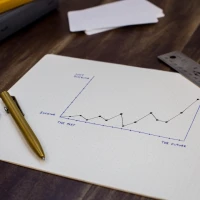Graphing linear equations can be as straightforward as sketching a simple line on a piece of paper. Yet, for many students and professionals alike, the process can seem riddled with complexity. Fear not, for mastering this mathematical skill is well within your reach. Prepare to embark on a journey that will not only demystify the concept of graphing but also turn you into a confident navigator of linear landscapes. Let’s dive into the world of y-intercepts, slopes, and coordinate planes to unveil the method to the madness of graphing linear equations with ease and precision.
In the following paragraphs, we’ll explore five simple steps that will help you harness the power of graphing linear equations with confidence. Whether you’re a novice needing clear-cut guidance or a seasoned mathematician looking for a refresher, this article promises to equip you with the tools necessary to graph linear equations like a pro.
Step 1: Understanding the Basics of Linear Equations
Before we start plotting points and drawing lines, let’s ensure we have a solid foundation. A linear equation is an algebraic equation in which each term is either a constant or the product of a constant and a single variable. Linear equations look like this: y = mx + b, where m is the slope, and b is the y-intercept.
The Slope (m)
The slope is a measure of the steepness of the line and is calculated as the rise over the run – the change in y over the change in x between two distinct points on the line.
The Y-Intercept (b)
The y-intercept is the point where the line crosses the y-axis. It is the value of y when x is zero.
Understanding these two fundamental components will make graph theory for beginnersing linear equations more intuitive and manageable.
Step 2: Plotting the Y-Intercept
Start your graphing journey by identifying the y-intercept (b) from your equation. This is your starting point.
Finding the Y-Intercept
- Look at your linear equation and locate the constant term that stands alone (not multiplied by x).
- Place a point on the y-axis of your coordinate plane at the value of this constant term.
Example:
In the equation y = 2x + 3, the y-intercept is 3. Place a point at (0, 3) on the graph.
Step 3: Using the Slope to Find Another Point
After plotting the y-intercept, use the slope (m) to determine another point on the line. The slope tells you how to move from the y-intercept to another point on the Odd cycle graph algorithms via the rise and run.
Calculating the Rise and Run
- From the y-intercept, move vertically the number of spaces that correspond to the numerator of your slope.
- Move horizontally in accordance with the denominator of the slope.
Example:
For a slope of 2 (which can also be written as 2/1), move 2 units up (the rise) and 1 unit to the right (the run) to find a new point.
Step 4: Drawing the Line
With at least two points plotted (the y-intercept and the one found using the slope), draw a straight line through these points to represent the linear equation.
Ensuring Accuracy
- Use a ruler or a straightedge to ensure your line is straight.
- Extend the line beyond the points, making sure it crosses the entire graph.
Verifying Your Line
- Check that your line crosses the y-axis at the y-intercept.
- Confirm that the slope between the points matches the slope given in the equation.
Step 5: Checking Your Work
Lastly, accuracy is paramount in graphing, so take time to verify your graph. Here’s how:
Verification Methods
- Pick a point not used in drawing your line, substitute its coordinates into the original equation, and see if it holds true.
- Ensure the visual slope of your line matches the numerical slope (m) of your equation.
Common Mistakes to Avoid
- Forgetting to use the sign of the slope (positive or negative), which indicates the direction of the line.
- Not extending the line across the entire graph, which could lead to incorrect reading of solutions or intercepts.
The Role of Graphing in Understanding Linear Relationships
Graphing isn’t solely about plotting points and lines; it’s a visual representation of relationships between variables. When graphing linear equations, each line on the graph tells a story of how changes in one variable reflect changes in another.
Why Graphing Matters
- Provides a visual method to solve equations.
- Helps with making predictions based on trends observed in the data.
- Essential for identifying whether a set of data follows a linear trend.
Graphing in Real-World Scenarios
Graphing plays a pivotal role in various fields, such as in economics for supply and demand curves, in physics for displaying motion over time, and in finance for trend analysis.
Interactive Comparison: Slope and Y-Intercept
Let’s use a comparison chart to visualize how different values of the slope (m) and y-intercept (b) affect the graph of a linear equation.
| Equation | Slope (m) | Y-Intercept (b) | Line Description |
|---|---|---|---|
| y = x + 1 | 1 | 1 | A straight line with a moderate upward slope, passing through (0, 1). |
| y = -x - 2 | -1 | -2 | A straight line with a moderate downward slope, passing through (0, -2). |
| y = 3x + 0 | 3 | 0 | A steeper, upward-sloping line passing through the origin (0, 0). |
| y = 0.5x + 5 | 0.5 | 5 | A gentler upward slope beginning at (0, 5). |
From this table, you can see how altering the values of m and b creates a variety of lines on the graph.
Best Practices for Mastering Graphing
As with any skill, there are tips and tricks to help you graph like a pro. Here are some best practices to keep in mind:
- Practice regularly: The more you graph, the more natural it becomes.
- Understand the theory: Knowing why things work makes it easier to remember how they work.
- Use quality graphing paper: This helps maintain accuracy in your graphs.
- Double-check your work: Ensure that your graph reflects the correct equation.
- Stay organized: Keep your work neat and legible, as it reduces errors and confusion.
Tools for Effective Graphing
- Graphing Calculator: An invaluable tool for checking your work and understanding complex graphs.
- Graphing Software: Useful for creating precise and detailed graphs.
- Online Tutorials: There’s a wealth of information online that can reinforce learning and provide alternative explanations.
In Conclusion: Confidence in Graphing Gained
From unpacking the essence of the slope and the y-intercept to traversing the graph with precision, this guide to graphing linear equations is your pathway to mastery. By following these five simple steps and employing best practices, you can confidently illustrate linear relationships and interpret them with ease. Remember, the line on your graph isn’t just a collection of points; it represents the harmony of mathematics in depicting real-world phenomena. Whether for academic endeavors, professional pursuits, or simply for the love of numbers, your newfound skills in graphing linear equations will serve as a dependable tool in your analytical arsenal.










